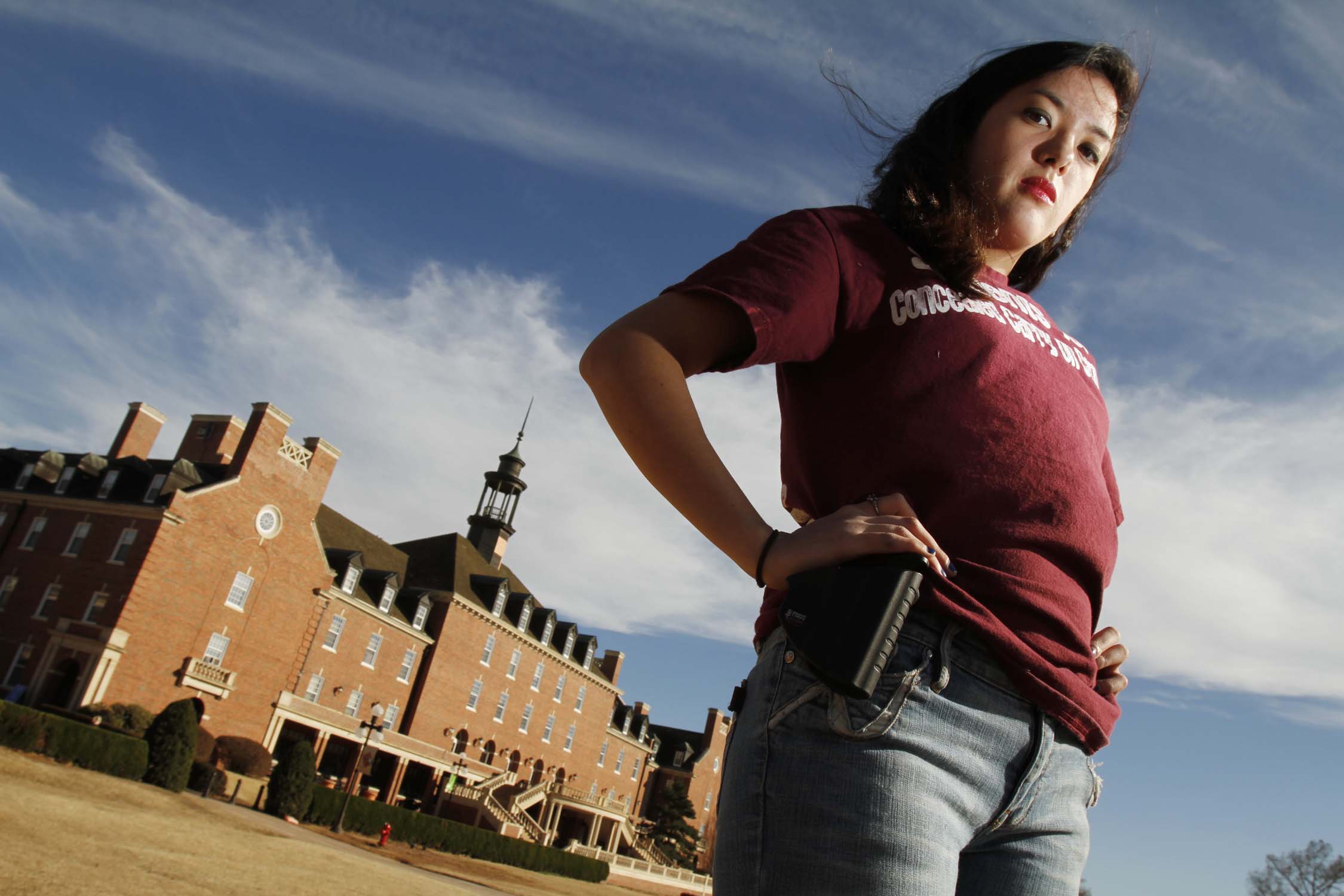At noon on Saturday, half a dozen armed men convened on the rooftop of the San Antonio Street parking garage at the University of Texas at Austin (UT). They were there to participate in the latest chapter in a drawn-out fight over the state’s new “campus carry” law, which, come August, will allow licensed individuals to bring concealed handguns into university buildings. Weaving through a scrum of media, the gun advocates descended on the street below, and paraded through a bustle of students in the midst of the exam-season crunch. After a short lunch break, they took their positions for a new and provocative display of gun-rights activism: the mock mass shooting.
“Most mass shootings occur in gun free zones,” said Matthew Short, a spokesman for Come and Take It Texas, repeating a common — but debunked — talking point. Short said that Saturday’s event would “inform the public about the dangers” of a gun-free campus by demonstrating how quickly an “evil person” could kill unarmed students. After the short performance, the group traced chalk outlines around the bodies on the sidewalk outside Duren Hall, a dormitory, and left the area smeared with ketchup, symbolizing blood.
Media feasted on the event — and its flatulent opposition — but for some members of the UT community, it brought back memories of the damage a real gunman can do. Buildings and concrete balustrades on campus still show the divots where bullets struck on an August morning in 1966, when a sniper armed with a high-powered rifle nestled in an observation deck of the university’s clock tower. In the nearly two hours that passed before police neutralized Charles Whitman, 48 people were injured or killed.
“It started for me with a colleague of mine, who was running around the halls of Parlin shouting ‘Don’t go outside, there’s someone out there with a gun,’” Alan Friedman, a professor of English at UT who was on campus during the massacre, tells The Trace. “You could see puffs of smoke accompanied by sounds of shooting which were coming from the top of the tower, from the observation deck. And there were already some people lying out on the south mall, who may or may not have been shot. You couldn’t tell at that point.”
Members of Saturday’s demonstration said that incidents like the clock tower shooting are why students should be armed. At one point, using a bullhorn to be heard over the chanting crowd, Short proclaimed that armed civilians “helped end” the tower shooting, by returning fire with their privately owned weapons. Friedman has another view. “There were others who went back and got their weapons and started shooting at the tower,” he says. “I don’t know if they did any harm, but they certainly didn’t do any good.”
One of those armed civilians, Allen Crum, did accompany police onto the observation deck of UT’s clock tower in the moments before the shootout ended. Crum’s only contribution to the gun battle was to accidentally discharge his rifle as police were getting into position.

The notion that armed students or professors might stop a mass shooting has been hotly debated both locally and nationally. With no prior firearms experience, UT senior Zachary Stone signed up for a Concealed Handgun License class to see if he would learn how to intervene in an active shooter scenario. The required training for a CHL in Texas was reduced in 2013 from 10 hours of instruction to just four. “After almost zero training and a 10-minute test, the State of Texas considers me responsible to carry a gun,” Stone wrote in an editorial for the New York Times. “I am not an outlier. According to the Texas Department of Public Safety, 99.7 percent of applicants in 2014 received their license.”
Indeed, the open carry of rifles and shotguns is already allowed under current Texas law, even without a license. But at Saturday’s demonstration, at least one protester was showing how blurred the legal lines can be, openly carrying a semi-automatic handgun — which remains a violation of the Texas Penal Code until a new open carry law kicks in on January 1. The man with the handgun identified himself as “Murdoch Pizgatti,” Founder and President of Come and Take It Texas. His real name is Zachary Horton, and he told Houston Chronicle reporter Lauren McGaughy that his gun was “accidentally showing” — for over three hours.
Texas’s campus carry law takes effect on August 1st, exactly on the 50th anniversary of the tower shooting. “I definitely think there will be some anxiety and students will feel uncomfortable going to class,” says Danielle Vabner, a UT student whose brother Noah was among 20 children killed three years ago at Sandy Hook Elementary School. Saturday’s event, for her, “crossed so many lines.”
Reflecting again on his experience of UT’s first mass shooting, Professor Friedman said, “The other image that sticks in my mind from that day is that after it was all over, in addition to the mayhem that I saw during the shooting and the harm that Whitman did, there was a student wandering around the halls of Parlin with his rifle — he’d obviously gone to get it to participate in the action. I remember him saying, ‘Well, now that that’s over, I’m going to go talk to my TA about my grade’ and he walked down the hall wielding his rifle.”
Matt Valentine is a writer and adjunct instructor at the University of Texas at Austin.
[Photos: Matt Valentine]


